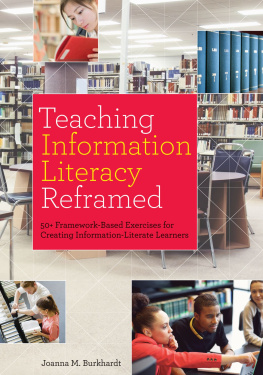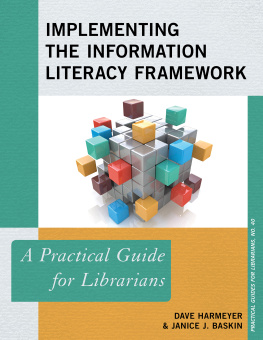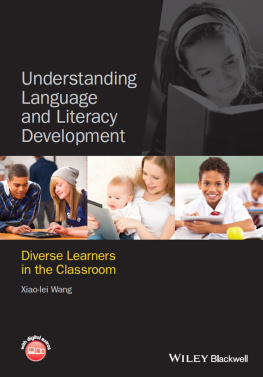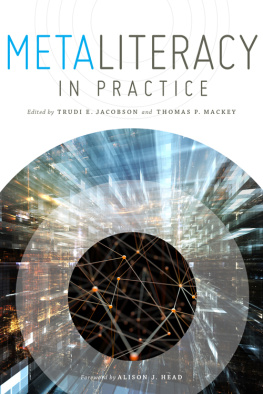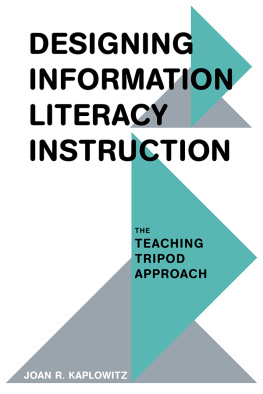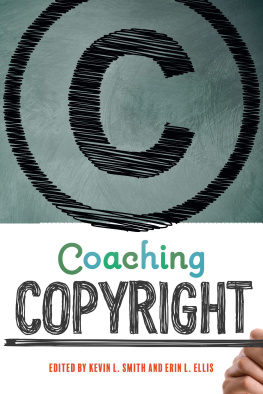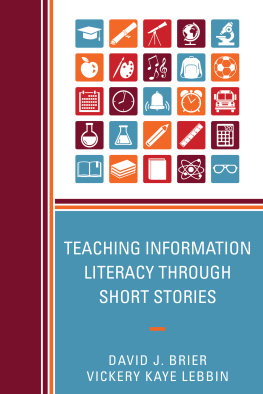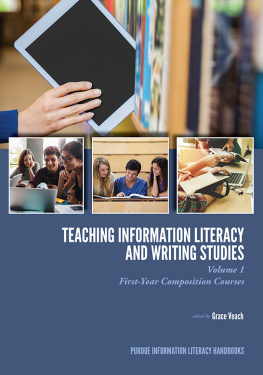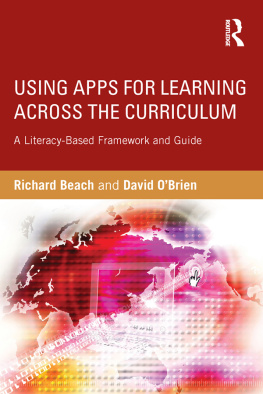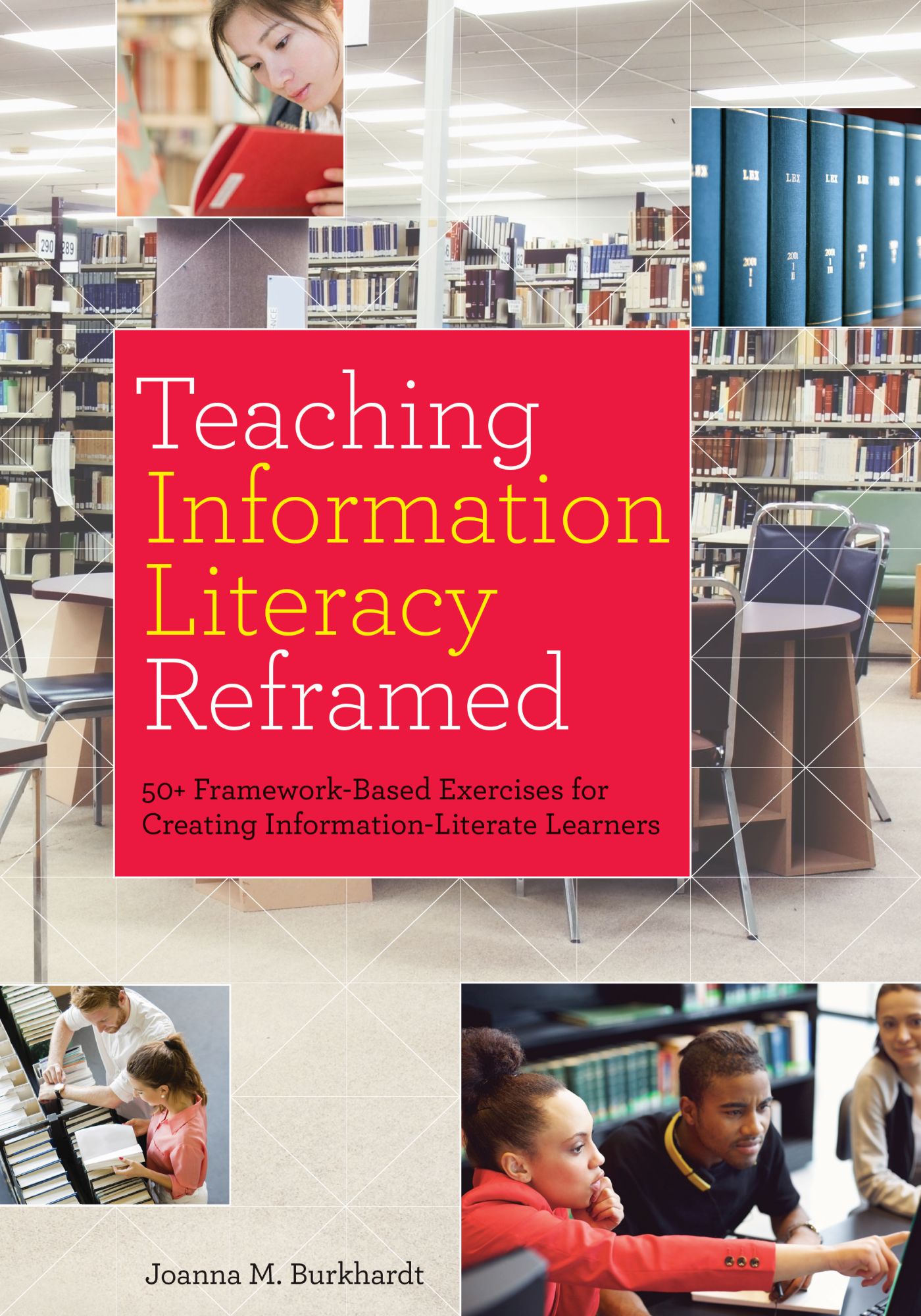
ALA Neal-Schuman purchases fund advocacy, awareness, and accreditation programs for library professionals worldwide.

Joanna M. Burkhardt is collection management officer and director of the Narragansett Bay Campus and Providence Campus branch libraries of the University of Rhode Island. Her research has focused on information literacy and instruction, assessment, and collection development. She is lead author of Teaching Information Literacy: 50 Standards-Based Exercises for College Students and Creating a Comprehensive Information Literacy Plan. She has written numerous articles and made presentations about instruction and information literacy. She has reviewed books for Library Journal and American Reference Books Annual for more than thirty years.
2016 by the American Library Association
Extensive effort has gone into ensuring the reliability of the information in this book; however, the publisher makes no warranty, express or implied, with respect to the material contained herein.
ISBNs
978-0-8389-1397-0 (paper)
978-0-8389-1451-9 (PDF)
978-0-8389-1452-6 (ePub)
978-0-8389-1453-3 (Kindle)
Library of Congress Cataloging-in-Publication Data
Names: Burkhardt, Joanna M.
Title: Teaching information literacy reframed : 50+ framework-based exercises for creating information-literate learners / Joanna M. Burkhardt.
Description: Chicago : ALA Neal-Schuman, an imprint of the American Library Association, 2016. | Includes .
Identifiers: LCCN 2016004845| ISBN 9780838913970 (print : alk. paper) | ISBN 9780838914526 (epub) | ISBN 9780838914533 (kindle)
Subjects: LCSH: Information literacyStudy and teaching (Higher)
Classification: LCC ZA3075 .B87 2016 | DDC 028.7071/1dc23 LC record available at https://lccn.loc.gov/2016004845
I dedicate this book to my husband, Michael, and my daughter, Katie. Their unfailing encouragement, support, and optimism make all things possible for me.
Contents
I would like to acknowledge the University of Rhode Island Libraries, where much of my information literacy training and experience have taken place. I would also like to acknowledge all the other hardworking instruction librarians who have shared ideas and talked through concepts in information literacy with me over the years. Your insights have been invaluable.
One focus of this book is on understanding the six threshold concepts outlined in the Framework for Information Literacy for Higher Education and on imagining how instructors might help students cross those thresholds. Another focus is on discovering how memory and transfer of learning apply to the teaching of information literacy. This book also offers some advice about how to design information literacy instruction that will be effective for both instructor and student.
The Framework for Information Literacy for Higher Education (Framework) is a new document. Although its creation took quite some time, its actual usefulness to the instruction of information literacy has yet to be tested. Because the Framework is conceptual in nature, there is very little practical information for instructors to apply in their classrooms. Because the document is a framework, there are many gaps that must be filled in by individual instructors. The skin that will cover the Framework must be homegrown. The means by which this will happen is left to the individual institutions to determine. The Framework document urges librarians to work with faculty and administrators across their campuses to create a program of information literacy that will be incorporated into the curriculum in every subject on every level.
The Framework offers a description of the expert in information literacy but does not provide a roadmap to show how that person became an expert. The Framework describes what someone who is becoming information literate might think or do. It does not describe how to provide instruction for the beginner in information literacy, nor does it provide any guidance about instruction that will propel students over the six thresholds identified.
The six threshold concepts themselves are not easy to interpret. In some ways they mirror the learning objectives of the Information Literacy Competency Standards for Higher Education (Standards). In striving to conceptualize the mechanics of the Standards, the clarity of language and the concrete nature of the examples in the Standards have been lost. The Frameworks threshold concepts seem both hard to understand and hard to teach to.
This book offers a starting point for instructors of information literacy in understanding and teaching the six threshold concepts listed in the Framework document. The looks at learning, memory, and transfer of learning and provides some advice about how to design classroom exercises that will best help students master basic skills and concepts.
It is my hope that this book will help instructors create a local program of instruction for information literacy. Many of the exercises are designed for beginning students of information literacy. Others will be more useful for intermediate students. Some exercises can be used in the one-shot time frame whereas others are designed for longer class sessions and semester-long courses. Librarians have long been experts in adapting instruction ideas to fit their local need. I hope readers of this book will find some ideas they can work with to further the creation of information literate students.
Decoding the Framework for Information Literacy
T he Framework for Information Literacy for Higher Education is the product of a long process. In the late 1990s, the Association of College and Research Libraries (ACRL) responded to a need for students and instructors to move beyond demonstrating databases and learning which buttons to push. Students needed a more conceptual approach that would help them focus on the identification and retrieval of information they needed, rather than on which button to push in a specific database. ACRL created the Information Literacy Competency Standards for Higher Education as a guide for information literacy instruction:
These standards were reviewed by the ACRL Standards Committee and approved by the Board of Directors of the Association of College and Research Libraries (ACRL) on January 18, 2000, at the Midwinter Meeting of the American Library Association in San Antonio, Texas. These standards were also endorsed by the American Association for Higher Education (October 1999) and the Council of Independent Colleges (February 2004).
The purpose of the standards for information literacy in higher education was described as follows:
Developing lifelong learners is central to the mission of higher education institutions. By ensuring that individuals have the intellectual abilities of reasoning and critical thinking, and by helping them construct
The Information Literacy Competency Standards for Higher Education document contains a definition of information literacy. The document briefly discusses the relationship between information literacy and technology, higher education, and pedagogy. It describes the goals of assessing competency in information literacy and the relevance of assessment of information literacy skills and concepts. The five standards and twenty-two performance indicators were used successfully during the next decade to explain information literacy to nonlibrarians, to help instructors plan lessons, and to implant a culture of assessment in higher education. Many institutions of higher education accepted the

